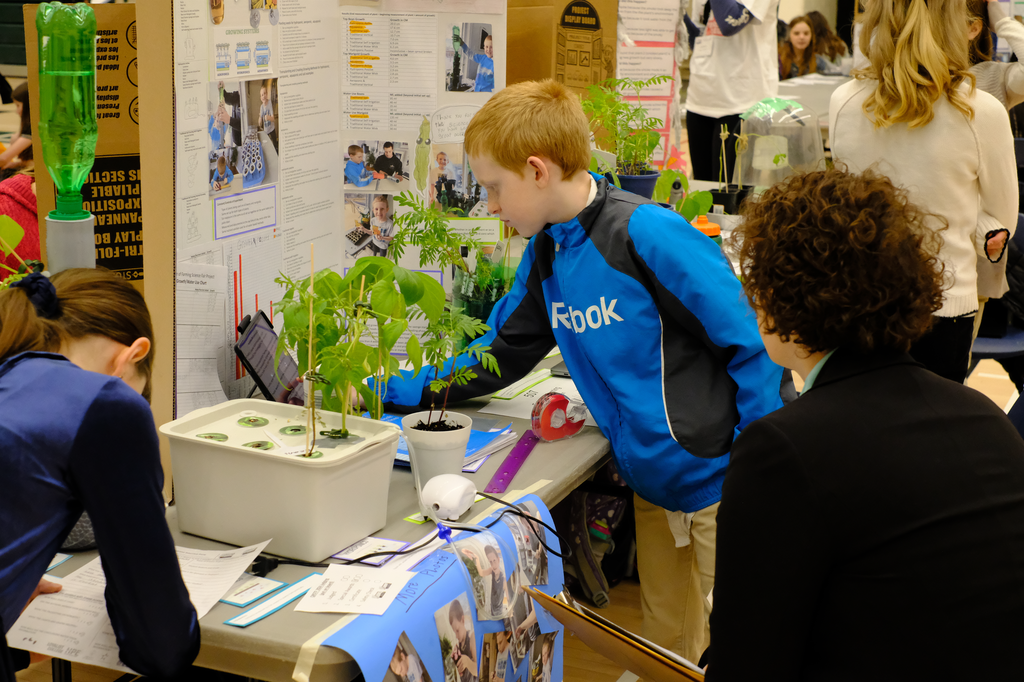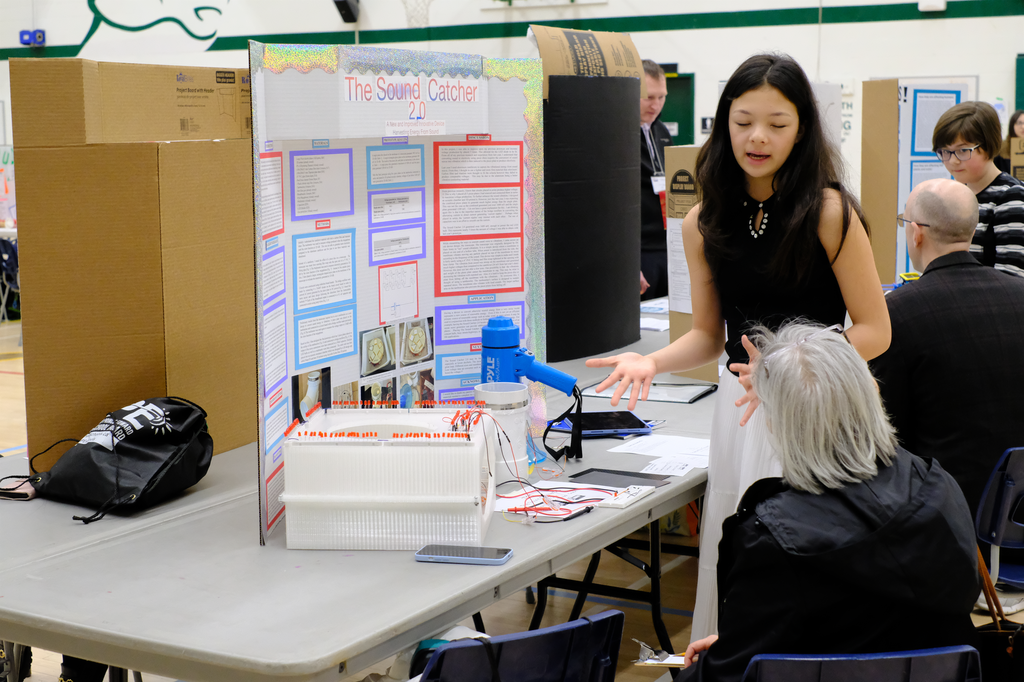Project Information
Project Organization
 All projects from grades 4-12 are divided for judging into grade groups. These groups could be from 3-6 projects. They are not divided by topic or classification. There are 5 different types of projects that brake down in two categories. The project is either of the two Challenges: "Discovery" or "Innovation"
All projects from grades 4-12 are divided for judging into grade groups. These groups could be from 3-6 projects. They are not divided by topic or classification. There are 5 different types of projects that brake down in two categories. The project is either of the two Challenges: "Discovery" or "Innovation"
Types of projects/Challenges::
![]() Discovery: Discovery is a combination of Experiments and Case Studies Experiment: Your project attempts to answer a scientific question and uses qualitative and quantitative data to support or fail to support a hypothesis.
Discovery: Discovery is a combination of Experiments and Case Studies Experiment: Your project attempts to answer a scientific question and uses qualitative and quantitative data to support or fail to support a hypothesis.
E.g., How does increasing the number of candles covered by a container affect the time it takes the candles to extinguish?
![]() Case Study: A case study is a descriptive and exploratory analysis and examination of a person, group, event, subject, devise or an aspect of nature. What type of relationship exists between ________ and ________? or How does a computer work? Innovation: Your project attempts to solve a problem or improve an existing solution. It may also be the creation of an invention or the improvement of one. (Invention)
Case Study: A case study is a descriptive and exploratory analysis and examination of a person, group, event, subject, devise or an aspect of nature. What type of relationship exists between ________ and ________? or How does a computer work? Innovation: Your project attempts to solve a problem or improve an existing solution. It may also be the creation of an invention or the improvement of one. (Invention)
![]() Innovation: Your project attempts to solve a problem or improve an existing solution. It may also be the creation of an invention or the improvement of one. (Invention)
Innovation: Your project attempts to solve a problem or improve an existing solution. It may also be the creation of an invention or the improvement of one. (Invention)
Video - Trifold - On the Board
Power point presentation on what should be a trifold board.. Excellent presentation ideas...
Here is a five minute video on What should be on a Trifold Board: Excellent video.. See if you recognize a picture at the beginning.
AI has become an ever-increasing presence. in our world. We should approach it with caution. QRSTF, with this policy has tried to make sure that all ethics and safety guidelines are covered. This video will explain the main points of the policy.
Use of AI in Science Projects...
 All projects from Grades 4-12 are classified and organized by grade to help the judges to understand and determine the level of background expertise. This does not mean that the students cannot exceed their grade level. Science Fair projects are an excellent opportunity for students to exceed expectations, improve their oral, written, scientific and mathematical skills.
All projects from Grades 4-12 are classified and organized by grade to help the judges to understand and determine the level of background expertise. This does not mean that the students cannot exceed their grade level. Science Fair projects are an excellent opportunity for students to exceed expectations, improve their oral, written, scientific and mathematical skills.
The Quinte Regional Science and Technology Fair has always been committed promoting and recognizing excellent in the Quinte are. We continually look for students that demonstrate excellence in STEM and STEM
The QRSTF categories are: Junior (grade 4 to 6) Intermediate (grade 7 and 8) Senior (grade 9 to 12) |
The Canada-Wide Science Fair categories are:
|
Canada-wide Science Fair
 "
"At the Quinte Regional Science and Technology Fair, there is a select committee made up of professionals, and CWSF judges that select the projects that will attend the next CWSF.
Tips and Tricks for Success at QRSTF and CWSF
Scientific Method explained... in pdf for you to check out.
These are provided to help you excel and to make your project exceptional.
 Log Book/Research Notebook: It is important to have a logbook to record your thoughts and process as your project develops, every step of the way. A good logbook will have images, sketches, notes, dates for each entry, and background research. This will help you to complete your project board. If you attend the Canada-wide Science Fair, you will be asked to upload up to 5 pages of your logbook for the judges to view.
Log Book/Research Notebook: It is important to have a logbook to record your thoughts and process as your project develops, every step of the way. A good logbook will have images, sketches, notes, dates for each entry, and background research. This will help you to complete your project board. If you attend the Canada-wide Science Fair, you will be asked to upload up to 5 pages of your logbook for the judges to view.  Research, Research, Research.
Research, Research, Research.  Take a look at the projects Online at the CWSF virtual Fair. They may not be on a printed project board but they will provide great ideas on how a project should be done. CWSF Virtual
Take a look at the projects Online at the CWSF virtual Fair. They may not be on a printed project board but they will provide great ideas on how a project should be done. CWSF Virtual  Look over the judging forms of the Canada-wide Science Fair and the Quinte Regional Science and Technology Fair.
Look over the judging forms of the Canada-wide Science Fair and the Quinte Regional Science and Technology Fair. If you have questions about your project.. contact us.
If you have questions about your project.. contact us.  Ethics is important before you start. Please check out our ethics chart to see if your project needs permission before you start. If you use humans or animals in your projects, check out our documents page - ethics section for the forms you may need to submit. There are many concerns when humans are involved. If you are not sure ask.
Ethics is important before you start. Please check out our ethics chart to see if your project needs permission before you start. If you use humans or animals in your projects, check out our documents page - ethics section for the forms you may need to submit. There are many concerns when humans are involved. If you are not sure ask.  Ensure that safety best practices are followed at all times during your experiment: If you are not sure about what is safe practices for you experiment please contact us and we will help you through the process. It is suggested that you work with an adult supervisor. Safety Chart
Ensure that safety best practices are followed at all times during your experiment: If you are not sure about what is safe practices for you experiment please contact us and we will help you through the process. It is suggested that you work with an adult supervisor. Safety Chart  Expand your project and make it as thorough and complete as possible. This means that you should not just do the least amount of trials but expand it to show more of what you can do. Always question your work and strive to expand on all areas.
Expand your project and make it as thorough and complete as possible. This means that you should not just do the least amount of trials but expand it to show more of what you can do. Always question your work and strive to expand on all areas.  Images: Take pictures as you progress in your project. Use your cell phone or a digital camera. Some have even taken videos of their work at they progressed.
Images: Take pictures as you progress in your project. Use your cell phone or a digital camera. Some have even taken videos of their work at they progressed.

